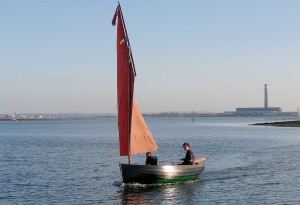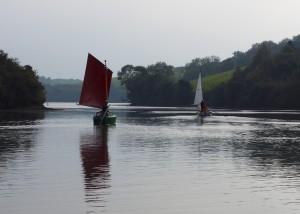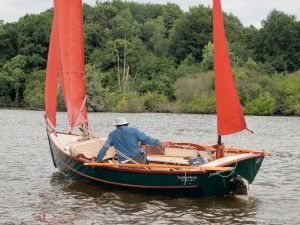Cruising in a dinghy can get you across seas – and further up creeks than yachts, advises Roger Barnes
Why do you cruise in a dinghy rather than a cabin yacht?” I am often asked by sundry quayside loiterers, as I go about my business on board. “Don’t you find a dinghy really restricting? You need a proper yacht to really explore the coastline. And isn’t it extraordinarily uncomfortable? I could never be that Spartan.”
Actually dinghies can get you about very efficiently, if you want them to. I have a friend who used to sail his 15ft dinghy across the English Channel simply to save the ferry fare, and on the long crossing from Devon to the Channel Islands too. A Drascombe Lugger once sailed nearly all the way round the world, Wayfarers often cross the North Sea, and a Ness Yawl was recently sailed and rowed from Britain to the Black Sea.
On the other hand, I have a number of friends in the Dinghy Cruising Association who invariably sail from the same familiar launching sites and rarely take their dinghies outside the sheltered waters of the Solent, but they go out sailing a number of times every month, even in winter, and they have an intimate and subtle knowledge of the nuances and intricacies of that stretch of water.
My own cruises lie between these extremes. I enjoy the excitement of exploring new waters, and often tow my dinghy to a distant unknown coastline, to spend a number of days living on board and exploring the coast. But I see no point in making a long overnight passage in a dinghy, just to say I have done it, if I can put my dinghy aboard a regular ferry service serving the same route. Even so, I often sail out of sight of land when on passage to an offshore island or crossing a deep indentation in the coastline, and this feels adventurous enough in a small open boat.
So here we are then, you and I, aboard a typical cruising dinghy, out at sea. The serried swell rolls towards us from the unbroken horizon, for even off the crowded coast of Europe there is often no other vessel in sight. Our dinghy rises to the faces of the oncoming seas, and then swoops down into the troughs beyond, picking her way across the ever-changing face of the deep. A wavetop catches her unawares and crashes aboard, drenching her up forward and running down into the boat. We work the pumps at intervals to keep the water under the bottom boards. A flock of storm petrels breaks the loneliness, dodging over the wave tops and flashing their white rumps.
Aboard a cruising dinghy on passage, the routine is the same as on any other sailing vessel. There is the timeless ritual of regular log entries, checking her position and marking it up on the chart. The weather is always a concern. Is the wind strengthening or slackening, backing or veering? Does she need another reef or would she make better progress under more sail? Meanwhile the helmsman craves a constant supply of drinks and nibbles. Fortunately ample quantities were prepared in advance and stowed close to the helm.
We look around our boat with pride as she breasts the swell. A true seaboat can always be recognised from her simplicity, robustness and sense of order. Everything is smart and seamanlike. There is no affectation or redundancy, just the minimum of tough, well-chosen gear. She may be scuffed and salt-stained, but she exudes a quiet competence that lesser-used yachts can never match.
Onwards we sail, and the sun begins to sink in the sky, the air grows colder and the sea becomes greyer and more menacing. But she is close to her destination now, and soon the arms of the estuary reach out to embrace her. We run in over the rough water on the bar and enter the shelter beyond. This is when a cruising yacht would pick up a visitor’s buoy, slip into a marina or look for a suitable all-tide anchorage. But cruising dinghies do not need to moor in deep water, to fret at their cable among a crowd of other boats, nor do they visit marinas very often.
Unlike those stand-offish yachts with their deep keels, dinghies have an intimate relationship with the coastline. Traditionally, small open boats were designed to operate close inshore, inside any off-lying shoals, making use of the counter currents and eddies in the shallows, and working out of tiny drying coves and creeks. They are creatures of the littoral, and the green parts of the chart are their natural habitat.

With the tent cover erected over the open well of the boat and the stove lit for a brew, the interior of the dinghy begins to dry out
As usual the sea breeze is blowing up the river valley, so we sail straight through the crowd of boats in the deepwater anchorage and into the open water beyond, heading into the upper reaches of the river. If the crew were hankering after a run ashore, we might think about drying out on a sandy beach, close to a convivial pub. But tonight our needs are simple: we just want a quiet anchorage in a remote upriver creek, well away from the crowds.
Our dinghy heels to a sudden gust and slips away around the corner up the river. The valley narrows. Trees reach down to dip their leaves into the water. We drift past an abandoned quayside, ivy cloaking the ruins of warehouses and limekilns. Then the valley widens out again and the sun glistens golden on a broad river pool. The bottom should be soft and flat here. It will be a peaceful night once she has settled onto the mud.
With the tent cover erected over the open well of the boat and the stove lit for a brew, the interior of the dinghy begins to dry out. The same vessel that was lashed by the waves of the open sea has become a snug home. We kick off our sea boots and remove our outer gear, then lay out the mattresses and scatter some cushions around. Soon we are lounging comfortably, watching the view swing past through the stern flaps of the boat tent. The sense of enclosure created by just a thin wall of canvas is remarkable. There is a feel of comfortable homeliness aboard. We sip our drinks and chat about the day’s voyage.
A night in a camping dinghy is very different from the experience of sleeping in a cabin yacht at anchor. We have a profound sense of being an intrinsic part of the natural environment, surrounded by the dabbling and splashing of the creatures of the foreshore. Inevitably we wake in the night. The wind has risen and the boat is snatching at her rode. We open the tent flaps and peer out. The beauty and splendour of the night sky deep in the countryside is breathtaking. Stars carpet the heavens, and the dark shadow of the skyline sways past as she swings insistently to her cable. We check the transit we took before turning in. It is still in line. The anchorage is well sheltered and she has not budged. We snuggle back down into our bunks again, reassured.
Some time later we look out again. The noise of burbling water under her hull has ceased. She has settled on the mud and now lies rock solid. The moon is high in the sky and the mud banks gleam in its light. We lie there for a while watching the scene and listening to the almost imperceptible hissing and scuffling in the mud all around, where small life breathes and feeds.
Next time we look out the boat is once more afloat and the seabirds are following the rising tide up the mudbanks. Dawn is well risen and the sun is burning off the morning mist. The water steams around our dinghy and fog lies in the hollows of the surrounding fields and woodlands. As usual early in the morning in summer, there is a light land breeze blowing down the valley towards the sea. We decide to strike the tent quickly and get back down to the mouth of the estuary while it lasts.
There is just time for a quick breakfast – a cup of tea and some cereal. The stove is fired up again and the fresh milk is fished out from the ‘cool store’ in the bilges. Then the sleeping bags and cushions are shaken out and crammed into stuff bags, the mattresses are rolled away and placed with them in roll-top dry bags, which are stowed out of the way and lashed down. The stove and galley boxes are closed and pushed into their seagoing positions.
Like other yachtsmen, we enjoy buying gear for our small craft: dinghy cruisers are not strangers to yacht chandleries. But much of the stuff in there has no relevance to us. Indeed it is noticeable that experienced dinghy cruisers tend to reduce their equipment over time, not add to it. It is like a constant process of Buddhist refinement. There is beauty in simplicity.
But we are not Spartans. The fewer pieces of equipment one has, the more important each particular item becomes, and the more demanding you become that it performs efficiently. Like minimalist backpackers, rather than acquire more gear we tend to replace cheap gear by more expensive and higher-quality stuff. We invest in better and more comfortable mattresses, or higher quality sleeping bags. But unlike minimalist backpackers, we have space for additional luxuries. There are bottles of wine, beer and whisky beneath the bottom boards. We drink decent coffee. We eat well. We want for little in our simple sailing boats.
Gear stowed, we raise the anchor and slip away from our upriver anchorage. The last shreds of mist wisp across the water before us. There is little wind, and our sail hangs limp in the crisp morning light, but the ebb tide carries us through the calm patches.
As we ghost silently down the river, a yacht passes under power. Her crew wave happily, while they shatter the peace of the morning. We wave cheerfully back, but are impatient for them to be gone so tranquillity is restored to the watercourse. We understand why yachts do this. Unlike us they cannot row if the wind abruptly dies, and they are fearful of running aground or hitting other moored craft.
Most sailing yachts motor most of the time. It is how things are in these sad latter days, part of the Faustian pact yachts have made in return for their spacious cabins, padded banquettes, drinks cabinets and fixed berths. But we wonder if they realise how much they have lost.
Roger Barnes is president of the Dinghy Cruising Association and author of The Dinghy Cruising Companion (pub Adlard Coles, £16.99)








